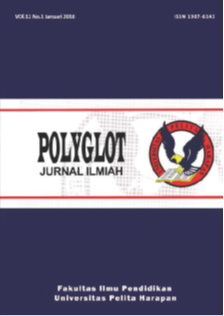Kepemimpinan Transformasional Kepala Sekolah [Transformational Leadership in School Principals]
DOI:
https://doi.org/10.19166/pji.v12i1.376Kata Kunci:
transformational leadership, school principal, kepemimpinan, transformasional, kepala sekolah, organisasiAbstrak
For an organization to thrive, it must have a good leader. A good leader is one who has the ability to influence his/her followers, putting them at ease, helping them experience joy in their work, and bringing about positive change. There are various kinds of leadership styles today -- one of them is transformational leadership. Transformational leadership is regarded as an ideal style to be applied in an educational organization, specifically a school. It is believed that transformational leadership will help a school better development. To apply this kind of leadership, there are 7 principles that must be considered. They are simplification, motivation, determination, mobilization, preparation, facilitation, and innovation. Using these 7 principles, the head of the school should: determine and communicate the school’s vision and mission; evaluate and innovate the school policies; facilitate teacher and staff development; accept criticism and suggestions from teachers, staffs, parents, and students and respond positively. The head of the school should also be able to evaluate teacher and staff performance objectively, solve problems quickly and accurately, make good decisions, create a comfortable workplace, and motivate every person to give their best. Finally, the head of the school should be a role model for others.
BAHASA INDONESIA ABSTRAK: Organisasi yang berkembang pada kenyataannya tidak lepas dari seorang pemimpin yang baik. Pemimpin pada hakikatnya adalah seorang yang mampu mempengaruhi pengikutnya, membuat orang- orang yang dipimpinnya merasa nyaman dan sukacita, serta membawa perubahan positif. Banyak terdapat berbagai macam gaya kepemimpinan yang baik di era modern ini, salah satunya adalah gaya kepemimpinan transformasional. Gaya kepemimpinan transformasional ini dipandang ideal untuk diaplikasikan di sebuah organisasi sekolah untuk membawa sekolah ke perkembangan lebih baik. Untuk mengaplikasikan gaya kepemimpinan ini, maka ada 7 prinsip yang harus diperhatikan. Ketujuh prinsip tersebut adalah simplification, motivation, determination, mobilization, preparation, facilitation, dan innovation. Mengacu pada prinsip tersebut, maka hal yang dapat dilakukan kepala sekolah adalah dengan mengkomunikasikan visi dan misi, membuat standard kinerja yang jelas dan melakukan evaluasi, memperbaharui kebijakan, memfasilitasi guru dan staff untuk melakukan kebijakan baru yang ada dan untuk mengembangkan diri, mau menerima kritik dan saran dari segala pihak, guru, staff, orang tua murid, dan murid serta meresponinya dengan positif, menilai kinerja guru dan staff secara obyektif, cepat tanggap dalam mengatasi masalah dan mampu mengambil keputusan secara tepat dan benar, menciptakan suasana kerja yang nyaman dan memotivasi setiap individu yang ada di dalamnya untuk memenuhi dan melakukan tanggung jawabnya sehingga dapat memberikan hasil yang maksimal, memberikan dirinya sendiri sebagai contoh nyata.
Referensi
Bass, B. M., & Riggio, R. E. (2005). Transformational leadership. Jakarta: Psychology Press.
Danielson, C. (2006). Teacher leadership that strengthens professional practice. Alexandria, VA: ASCD.
Definisi kepemimpinan transformasional. (2011). Retrieved from http://www.majalahpendidikan.com/2011/04/pengertian-kepemimpinan.html
Tjiptono, F., & Diana, A. (2002). Total quality management. Yogyakarta: Andi.
Wintolo, R. K. (2011, August 5). Kepemimpinan transformasional [Blog post]. Retrieved from http://tankawuryan.blogspot.co.id/2011/08/kepemimpinan-transformasional.html
Unduhan
Diterbitkan
Terbitan
Bagian
Lisensi
Authors who publish with this journal agree to the following terms:
1) Authors retain copyright and grant the journal right of first publication with the work simultaneously licensed under a Creative Commons Attribution License (CC-BY-SA 4.0) that allows others to share the work with an acknowledgement of the work's authorship and initial publication in this journal.
2) Authors are able to enter into separate, additional contractual arrangements for the non-exclusive distribution of the journal's published version of the work (e.g., post it to an institutional repository or publish it in a book), with an acknowledgement of its initial publication in this journal.
3) Authors are permitted and encouraged to post their work online (e.g., in institutional repositories or on their website). The final published PDF should be used and bibliographic details that credit the publication in this journal should be included.





